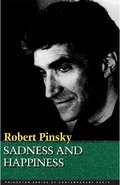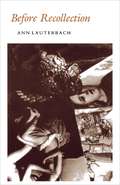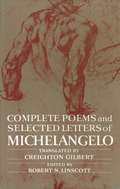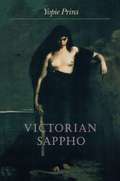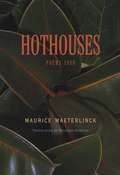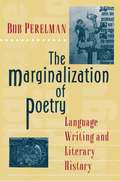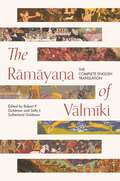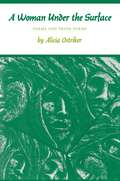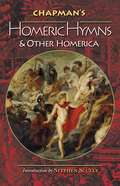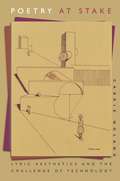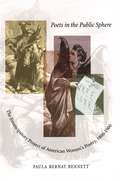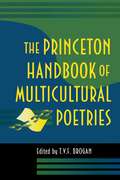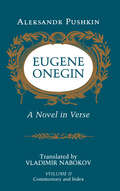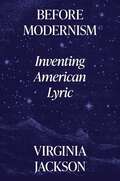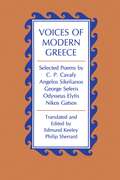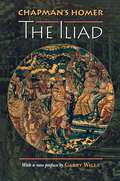- Table View
- List View
Sadness and Happiness: Poems by Robert Pinsky (Princeton Series of Contemporary Poets #160)
by Robert PinskyFrom Sadness and Happiness: Poems by Robert Pinsky:CEREMONY FOR ANY BEGINNING Robert Pinsky ? Against weather, and the randomHarpies--mood, circumstance, the lawsOf biography, chance, physics--The unseasonable soul holds forth,Eager for form as a renownedPedant, the emperor's man of worth,Hereditary arbiter of manners. Soul, one's life is one's enemy.As the small children learn, what happensTakes over, and what you were goes away.They learn it in sardonic softComments of the weather, when it sharpensThe hard surfaces of daylight: lightWinds, vague in direction, like blades Lavishing their brilliant strokesAll over a wrecked house,The nude wallpaper and the bruteIntelligence of the torn pipes.Therefore when you marry or buildPray to be untrue to the plainDominance of your own weather, how it keeps Going even in the woods when notA soul is there, and how it impliesAlways that separate, coldSplendidness, uncouth and unkind--On chilly, unclouded mornings,Torrential sunlight and moist air,Leafage and solid bark breathing the mist.
Before Recollection (Princeton Series of Contemporary Poets #161)
by Ann LauterbachFrom Before Recollection:TRANSCENDENTAL POSTCARD Ann Lauterbach ? The outlook such that time is told on waking,Without aid of cock or clock's crow.In fact all the birds are elsewhere,Poised on glossy page or in some fallMigration. Sun up over mountain is precision,Then mist travels, exhaling day.All else, all change, is air,Dew relenting on the bladesAnd mirror rhymesWhere water bears resemblance:A strut of hues to pale even Revlon's alchemy and,In the center of its glaze, a cauldron of sky-cast blue.
The Situation of Poetry: Contemporary Poetry and Its Traditions (Princeton Essays in Literature #3)
by Robert PinskyIn this book Robert Pinsky writes about contemporary poetry as it reflects its modernist and Romantic past. He isolates certain persistent ideas about poetry's situation relative to life and focuses on the conflict the poet faces between the nature of words and poetic forms on one side, and the nature of experience on the other.The author ranges for his often surprising examples from Keats to the great modernists such as Stevens and Williams, to the contents of recent magazines. He considers work by Ammons, Ashbery, Bogan, Ginsberg, Lowell, Merwin, O'Hara, and younger writers, offering judgments and enthusiasms from a viewpoint that is consistent but unstereotyped.Like his poetry, Robert Pinsky's criticism joins the traditional and the innovative in ways that are thoughtful and unmistakably his own. His book is a bold essay on the contemporary situation in poetry, on the dazzling achievements of modernism, and on the nature or "situation" of poetry itself.
Complete Poems and Selected Letters of Michelangelo
by MichelangeloThe description for this book, Complete Poems and Selected Letters of Michelangelo, will be forthcoming.
Victorian Sappho
by Yopie PrinsWhat is Sappho, except a name? Although the Greek archaic lyrics attributed to Sappho of Lesbos survive only in fragments, she has been invoked for many centuries as the original woman poet, singing at the origins of a Western lyric tradition. Victorian Sappho traces the emergence of this idealized feminine figure through reconstructions of the Sapphic fragments in late-nineteenth-century England. Yopie Prins argues that the Victorian period is a critical turning point in the history of Sappho's reception; what we now call "Sappho" is in many ways an artifact of Victorian poetics. Prins reads the Sapphic fragments in Greek alongside various English translations and imitations, considering a wide range of Victorian poets--male and female, famous and forgotten--who signed their poetry in the name of Sappho. By "declining" the name in each chapter, the book presents a theoretical argument about the Sapphic signature, as well as a historical account of its implications in Victorian England. Prins explores the relations between classical philology and Victorian poetics, the tropes of lesbian writing, the aesthetics of meter, and nineteenth-century personifications of the "Poetess." as current scholarship on Sappho and her afterlife. Offering a history and theory of lyric as a gendered literary form, the book is an exciting and original contribution to Victorian studies, classical studies, comparative literature, and women's studies.
Hothouses: Poems, 1889 (Facing Pages #2)
by Maurice MaeterlinckOn May 31, 1889, a young Belgian lawyer from a wealthy bourgeois family in Ghent published a book of 33 poems in 155 copies. Maurice Maeterlinck's legal career was floundering but his road to literary greatness had begun. Long overshadowed by the plays that later won him the Nobel Prize, Serres chaudes (Hothouses) nonetheless came to be widely regarded as one of the cornerstones of literary Modernism after Baudelaire. While Max Nordau soon seized upon Maeterlinck's--tumult of images--as symptomatic of a pervasive social malaise, decades later Antonin Artaud pronounced, "Maeterlinck was the first to introduce the multiple riches of the subconscious into literature." Richard Howard's translation of this quietly radical work is the first to be published in nearly a century, and the first to accurately convey Maeterlinck's elusive visionary force. The poems, some of them in free verse (new to Belgium at the time), combine the decadent symbolism and the language of dislocation that Maeterlinck later perfected in his dramas. Hothouses reflects the influence not only of French poets including Verlaine and Rimbaud, but also of Whitman. As for the title, the author said it was "a natural choice, Ghent . . . abounding in greenhouses." The poems, whose English translations appear opposite the French originals, are accompanied by reproductions of seven woodcuts by Georges Minne that appeared in the original volume, and by an early prose text by Maeterlinck imaginatively describing a painting by the sixteenth-century Flemish artist Pieter Brueghel. A feat of daring power extraordinarily immediate and inventive, Hothouses will appeal to all lovers of poetry, and in particular to those interested in Modernism. Maeterlinck's enormous fame may have faded, but twentieth-century writers such as Beckett are still our masters who testify to its undying influence.
The Marginalization of Poetry: Language Writing and Literary History
by Bob PerelmanLanguage writing, the most controversial avant-garde movement in contemporary American poetry, appeals strongly to writers and readers interested in the politics of postmodernism and in iconoclastic poetic form. Drawing on materials from popular culture, avoiding the standard stylistic indications of poetic lyricism, and using nonsequential sentences are some of the ways in which language writers make poetry a more open and participatory process for the readers. Reading this kind of writing, however, may not come easily in a culture where poetry is treated as property of a special class. It is this barrier that Bob Perelman seeks to break down in this fascinating and comprehensive account of the language writing movement. A leading language writer himself, Perelman offers insights into the history of the movement and discusses the political and theoretical implications of the writing. He provides detailed readings of work by Lyn Hejinian, Ron Silliman, and Charles Bernstein, among many others, and compares it to a wide range of other contemporary and modern American poetry. A variety of issues are addressed in the following chapters: "The Marginalization of Poetry," "Language Writing and Literary History," "Here and Now on Paper," "Parataxis and Narrative: The New Sentence in Theory and Practice," "Write the Power," "Building a More Powerful Vocabulary: Bruce Andrews and the World (Trade Center)," "This Page Is My Page, This Page Is Your Page: Gender and Mapping," "An Alphabet of Literary Criticism," and "A False Account of Talking with Frank O'Hara and Roland Barthes in Philadelphia."
The Rāmāyaṇa of Vālmīki: The Complete English Translation (Princeton Library of Asian Translations #157)
by Robert P. Goldman Sally J. GoldmanThe definitive English translation of the classic Sanskrit epic poem—now available in a one-volume paperbackThe Rāmāyaṇa of Vālmīki, the monumental Sanskrit epic of the life of Rama, ideal man and incarnation of the great god Visnu, has profoundly affected the literature, art, religions, and cultures of South and Southeast Asia from antiquity to the present. Filled with thrilling battles, flying monkeys, and ten-headed demons, the work, composed almost 3,000 years ago, recounts Prince Rama’s exile and his odyssey to recover his abducted wife, Sita, and establish a utopian kingdom. Now, the definitive English translation of the critical edition of this classic is available in a single volume.Based on the authoritative seven-volume translation edited by Robert Goldman and Sally Sutherland Goldman, this volume presents the unabridged translated text in contemporary English, revised and reformatted into paragraph form. The book includes a new introduction providing important historical and literary contexts, as well as a glossary, pronunciation guide, and index. Ideal for students and general readers, this edition of the Rāmāyaṇa of Vālmīki introduces an extraordinary work of world literature to a new generation of readers.
The Rāmāyaṇa of Vālmīki: The Complete English Translation (Princeton Library of Asian Translations #157)
by Robert P. Goldman Sally J. GoldmanThe definitive English translation of the classic Sanskrit epic poem—now available in a one-volume paperbackThe Rāmāyaṇa of Vālmīki, the monumental Sanskrit epic of the life of Rama, ideal man and incarnation of the great god Visnu, has profoundly affected the literature, art, religions, and cultures of South and Southeast Asia from antiquity to the present. Filled with thrilling battles, flying monkeys, and ten-headed demons, the work, composed almost 3,000 years ago, recounts Prince Rama’s exile and his odyssey to recover his abducted wife, Sita, and establish a utopian kingdom. Now, the definitive English translation of the critical edition of this classic is available in a single volume.Based on the authoritative seven-volume translation edited by Robert Goldman and Sally Sutherland Goldman, this volume presents the unabridged translated text in contemporary English, revised and reformatted into paragraph form. The book includes a new introduction providing important historical and literary contexts, as well as a glossary, pronunciation guide, and index. Ideal for students and general readers, this edition of the Rāmāyaṇa of Vālmīki introduces an extraordinary work of world literature to a new generation of readers.
A Woman Under the Surface: Poems and Prose Poems (Princeton Series of Contemporary Poets #162)
by Alicia OstrikerFrom A Woman Under the Surface:MOON AND EARTH Alicia Ostriker ? Of one substance, of oneMatter, they have cruellyBroken apart. They never will touch Each other again. The shiningLovelier and youngerTurns away, a pitiful girl. She is completely nakedAnd it hurts. The largerMotherly one, breathlessly luminous Emerald, and blue, and whiteTraveling mists, suffersBirth and death, birth and death, and the shockOf internal heat killed by external cold.They are dancing through that blackness. They press as ifTo come closer.
What the Thunder Said: How The Waste Land Made Poetry Modern
by Jed RasulaOn the 100th anniversary of T. S. Eliot’s modernist masterpiece, a rich cultural history of The Waste Land’s creation, explosive impact, and enduring influenceWhen T. S. Eliot published The Waste Land in 1922, it put the thirty-four-year-old author on a path to worldwide fame and the Nobel Prize. “But,” as Jed Rasula writes, “The Waste Land is not only a poem: it names an event, like a tornado or an earthquake. Its publication was a watershed, marking a before and after. It was a poem that unequivocally declared that the ancient art of poetry had become modern.” In What the Thunder Said, Rasula tells the story of how The Waste Land changed poetry forever and how this cultural bombshell served as a harbinger of modernist revolution in all the arts, from abstraction in visual art to atonality in music.From its famous opening, “April is the cruellest month, breeding / Lilacs out of the dead land,” to its closing Sanskrit mantra, “Shantih shantih shantih,” The Waste Land combined singular imagery, experimental technique, and dense allusions, boldly fulfilling Ezra Pound’s injunction to “make it new.” What the Thunder Said traces the origins, reception, and enduring influence of the poem, from its roots in Wagnerism and French Symbolism to the way its strangely beguiling music continues to inspire readers. Along the way, we learn about Eliot’s storied circle, including Wyndham Lewis, Virginia Woolf, and Bertrand Russell, and about poets like Mina Loy and Marianne Moore, whose innovations have proven as consequential as those of the “men of 1914.”Filled with fresh insights and unfamiliar anecdotes, What the Thunder Said recovers the explosive force of the twentieth century’s most influential poem.
What the Thunder Said: How The Waste Land Made Poetry Modern
by Jed RasulaOn the 100th anniversary of T. S. Eliot’s modernist masterpiece, a rich cultural history of The Waste Land’s creation, explosive impact, and enduring influenceWhen T. S. Eliot published The Waste Land in 1922, it put the thirty-four-year-old author on a path to worldwide fame and the Nobel Prize. “But,” as Jed Rasula writes, “The Waste Land is not only a poem: it names an event, like a tornado or an earthquake. Its publication was a watershed, marking a before and after. It was a poem that unequivocally declared that the ancient art of poetry had become modern.” In What the Thunder Said, Rasula tells the story of how The Waste Land changed poetry forever and how this cultural bombshell served as a harbinger of modernist revolution in all the arts, from abstraction in visual art to atonality in music.From its famous opening, “April is the cruellest month, breeding / Lilacs out of the dead land,” to its closing Sanskrit mantra, “Shantih shantih shantih,” The Waste Land combined singular imagery, experimental technique, and dense allusions, boldly fulfilling Ezra Pound’s injunction to “make it new.” What the Thunder Said traces the origins, reception, and enduring influence of the poem, from its roots in Wagnerism and French Symbolism to the way its strangely beguiling music continues to inspire readers. Along the way, we learn about Eliot’s storied circle, including Wyndham Lewis, Virginia Woolf, and Bertrand Russell, and about poets like Mina Loy and Marianne Moore, whose innovations have proven as consequential as those of the “men of 1914.”Filled with fresh insights and unfamiliar anecdotes, What the Thunder Said recovers the explosive force of the twentieth century’s most influential poem.
Chapman's Homeric Hymns and Other Homerica (Bollingen Series (General) #169)
by HomerGeorge Chapman's translations of Homer--immortalized by Keats's sonnet-- are the most famous in the English language. Swinburne praised their "romantic and sometimes barbaric grandeur," their "freshness, strength, and inextinguishable fire." And the great critic George Saintsbury wrote, "For more than two centuries they were the resort of all who, unable to read Greek, wished to know what the Greek was. Chapman is far nearer Homer than any modern translator in any modern language." This volume presents the original text of Chapman's translation of the Homeric hymns. The hymns, believed to have been written not by Homer himself but by followers who emulated his style, are poems written to the gods and goddesses of the ancient Greek pantheon. The collection, originally titled by Chapman "The Crowne of all Homers Workes," also includes epigrams and poems attributed to Homer and known as "The Lesser Homerica," as well as his famous "The Battle of Frogs and Mice."
Poetry at Stake: Lyric Aesthetics and the Challenge of Technology
by Carrie NolandTaking seriously Guillaume Apollinaire's wager that twentieth-century poets would one day "mechanize" poetry as modern industry has mechanized the world, Carrie Noland explores poetic attempts to redefine the relationship between subjective expression and mechanical reproduction, high art and the world of things. Noland builds upon close readings to construct a tradition of diverse lyricists--from Arthur Rimbaud, Blaise Cendrars, and René Char to contemporary performance artists Laurie Anderson and Patti Smith--allied in their concern with the nature of subjectivity in an age of mechanical reproduction.
Poetry at Stake: Lyric Aesthetics and the Challenge of Technology
by Carrie NolandTaking seriously Guillaume Apollinaire's wager that twentieth-century poets would one day "mechanize" poetry as modern industry has mechanized the world, Carrie Noland explores poetic attempts to redefine the relationship between subjective expression and mechanical reproduction, high art and the world of things. Noland builds upon close readings to construct a tradition of diverse lyricists--from Arthur Rimbaud, Blaise Cendrars, and René Char to contemporary performance artists Laurie Anderson and Patti Smith--allied in their concern with the nature of subjectivity in an age of mechanical reproduction.
Poets in the Public Sphere: The Emancipatory Project of American Women's Poetry, 1800-1900
by Paula Bernat BennettBased entirely on archival research, Poets in the Public Sphere traces the emergence of the "New Woman" by examining poetry published by American women in newspapers and magazines between 1800 and 1900. Using sources like the Kentucky Reporter, the Cherokee Phoenix, the Cincinnati Israelite, and the Atlantic Monthly, Bennett is able to track how U.S. women from every race, class, caste, region, and religion exploited the freedom offered by the nation's periodical press, especially the poetry columns, to engage in heated debate with each other and with men over matters of mutual concern. Far from restricting their poems to the domestic and personal, these women addressed a significant array of political issues--abolition, Indian removals, economic and racial injustice, the Civil War, and, not least, their own changing status as civil subjects. Overflowing with a wealth of heretofore untapped information, their poems demonstrate conclusively that "ordinary" nineteenth-century women were far more influenced by the women's rights movement than historians have allowed. In showing how these women turned the sentimental and ideologically saturated conventions of the period's verse to their own ends, Bennett argues passionately and persuasively for poetry's power as cultural and political discourse. As much women's history as literary history, this book invites readers to rethink not only the role that nineteenth-century women played in their own emancipation but the role that poetry plays in cultural life.
Poets in the Public Sphere: The Emancipatory Project of American Women's Poetry, 1800-1900
by Paula Bernat BennettBased entirely on archival research, Poets in the Public Sphere traces the emergence of the "New Woman" by examining poetry published by American women in newspapers and magazines between 1800 and 1900. Using sources like the Kentucky Reporter, the Cherokee Phoenix, the Cincinnati Israelite, and the Atlantic Monthly, Bennett is able to track how U.S. women from every race, class, caste, region, and religion exploited the freedom offered by the nation's periodical press, especially the poetry columns, to engage in heated debate with each other and with men over matters of mutual concern. Far from restricting their poems to the domestic and personal, these women addressed a significant array of political issues--abolition, Indian removals, economic and racial injustice, the Civil War, and, not least, their own changing status as civil subjects. Overflowing with a wealth of heretofore untapped information, their poems demonstrate conclusively that "ordinary" nineteenth-century women were far more influenced by the women's rights movement than historians have allowed. In showing how these women turned the sentimental and ideologically saturated conventions of the period's verse to their own ends, Bennett argues passionately and persuasively for poetry's power as cultural and political discourse. As much women's history as literary history, this book invites readers to rethink not only the role that nineteenth-century women played in their own emancipation but the role that poetry plays in cultural life.
The Princeton Handbook of Multicultural Poetries
by Terry V. F. BroganDrawn from the acclaimed New Princeton Encyclopedia of Poetry and Poetics, the articles in this concise new reference book provide a complete survey of the poetic history and practice in every major national literature or cultural tradition in the world. As with the parent volume, which has sold over 10,000 copies since it was first published in 1993, the intended audience is general readers, journalists, students, teachers, and researchers. The editor's principle of selection was balance, and his goal was to embrace in a structured and reasoned way the diversity of poetry as it is known across the globe today. In compiling material on 106 cultures in 92 national literatures, the book gives full coverage to Indo-European poetries (all the major Celtic, Slavic, Germanic, and Romance languages, as well as other obscure ones such as Hittite), the ancient middle Eastern poetries (Hebrew, Persian, Sumerian, and Assyro-Babylonian), subcontinental Indian poetries (the widest linguistic diversity), Asian and Pacific poetries (Chinese, Japanese, Korean, Vietnamese, Mongolian, and half a dozen others), continental American poetries (all the modern Western cultures and native Indian in North, Central, and South American regions), and African poetries (ancient and emergent, oral and written).
Eugene Onegin: A Novel in Verse: Commentary (Vol. 2)
by Aleksandr PushkinWhen Vladimir Nabokov first published his controversial translation of Pushkin’s Eugene Onegin in 1964, the great majority of the edition was taken up by Nabokov’s witty and detailed commentary. Presented here in its own volume, the commentary is a unique and exhaustive scholarly masterwork by one of the twentieth century’s greatest writers—a work that Nabokov biographer Brian Boyd calls “the most detailed commentary ever made on” Onegin and “indispensable to all serious students of Pushkin’s masterpiece.”In his commentary, Nabokov seeks to illuminate every possible nuance of this nineteenth-century classic. He explains obscurities, traces literary influences, relates Onegin to Pushkin’s other work, and in a characteristically entertaining manner dwells on a host of interesting details relevant to the poem and the Russia it depicts. Nabokov also provides translations of lines and stanzas deleted by the censor or by Pushkin himself, variants from Pushkin’s notebooks, fragments of a continuation called “Onegin’s Journey,” the unfinished and unpublished “Chapter Ten,” other continuations, and an index.A work of astonishing erudition and passion, Nabokov’s commentary is a landmark in the history of literary scholarship and in the understanding and appreciation of the greatest work of Russia’s national poet.
On Czeslaw Milosz: Visions from the Other Europe (Writers on Writers #14)
by Eva HoffmanA compelling personal introduction to the life and work of Nobel Prize–winning writer Czesław Miłosz from his fellow Polish exile and acclaimed writer Eva HoffmanCzesław Miłosz (1911–2004) was a giant of twentieth-century literature, not least because he lived through and wrote about many of the most extreme events of that extreme century, from the world wars and the Holocaust to the Cold War. Over a seven-decade career, he produced an important body of poetry, fiction, and nonfiction, including classics such as The Captive Mind, a reflection on the hypnotic power of ideology, and Native Realm, a memoir. In this book, Eva Hoffman, like Miłosz a Polish-born writer who immigrated to the West, presents an eloquent personal portrait of the life and work of her illustrious fellow exile.Miłosz experienced the horrors of World War II in Warsaw—the very epicenter of the inferno—and witnessed the unfolding of the Holocaust from up close. After the war, he lived as a permanent exile—from Poland, communism, and mainstream American culture. Hoffman explores how exile, historical disasters, and Miłosz’s origins in Eastern Europe shaped his vision, and she occasionally compares her own postwar trajectory with Miłosz’s to show how the question of “the Other Europe” is still with us today. She also examines his later turn to the poetry of memory and loss, driven by the need to remember and honor his many friends and others killed in the Holocaust.Combining incisive personal and critical insights, On Czesław Miłosz captures the essence of the life and work of a great poet and writer.
From School to Salon: Reading Nineteenth-Century American Women's Poetry
by Mary LoeffelholzWith the transformation and expansion of the nineteenth-century American literary canon in the past two decades, the work of the era's American women poets has come to be widely anthologized. But scant scholarship has arisen to make full sense of it. From School to Salon responds to this glaring gap. Mary Loeffelholz presents the work of nineteenth-century women poets in the context of the history, culture, and politics of the times. She uses a series of case studies to discuss why the recovery of nineteenth-century women's poetry has been a process of anthologization without succeeding analysis. At the same time, she provides a much-needed account of the changing social contexts through which nineteenth-century American women became poets: initially by reading, reciting, writing, and publishing poetry in school, and later, by doing those same things in literary salons, institutions created by the high-culture movement of the day. Along the way, Loeffelholz provides detailed analyses of the poetry, much of which has received little or no recent critical attention. She focuses on the works of a remarkably diverse array of poets, including Lucretia Maria Davidson, Lydia Sigourney, Maria Lowell, Frances Ellen Watkins Harper, Emily Dickinson, Helen Hunt Jackson, and Annie Fields. Impeccably researched and gracefully written, From School to Salon moves the study of nineteenth-century women's poetry to a new and momentous level.
Before Modernism: Inventing American Lyric
by Virginia JacksonHow Black poets have charted the direction of American poetics for the past two centuriesBefore Modernism examines how Black poetics, in antagonism with White poetics in the late eighteenth and early nineteenth centuries, produced the conditions for the invention of modern American poetry. Through inspired readings of the poetry of Phillis Wheatley Peters, George Moses Horton, Ann Plato, James Monroe Whitfield, and Frances Ellen Watkins Harper—as well as the poetry of neglected but once popular White poets William Cullen Bryant and Henry Wadsworth Longfellow—Virginia Jackson demonstrates how Black poets inspired the direction that American poetics has taken for the past two centuries. As an idea of poetry based on genres of poems such as ballads, elegies, odes, hymns, drinking songs, and epistles gave way to an idea of poetry based on genres of people—Black, White, male, female, Indigenous—almost all poetry became lyric poetry. Jackson traces the twisted paths leading to our current understanding of lyric, along the way presenting not only a new history but a new theory of American poetry.A major reassessment of the origins and development of American poetics, Before Modernism argues against a literary critical narrative that links American modernism directly to British or European Romanticism, emphasizing instead the many ways in which early Black poets intervened by inventing what Wheatley called “the deep design” of American lyric.
Before Modernism: Inventing American Lyric
by Virginia JacksonHow Black poets have charted the direction of American poetics for the past two centuriesBefore Modernism examines how Black poetics, in antagonism with White poetics in the late eighteenth and early nineteenth centuries, produced the conditions for the invention of modern American poetry. Through inspired readings of the poetry of Phillis Wheatley Peters, George Moses Horton, Ann Plato, James Monroe Whitfield, and Frances Ellen Watkins Harper—as well as the poetry of neglected but once popular White poets William Cullen Bryant and Henry Wadsworth Longfellow—Virginia Jackson demonstrates how Black poets inspired the direction that American poetics has taken for the past two centuries. As an idea of poetry based on genres of poems such as ballads, elegies, odes, hymns, drinking songs, and epistles gave way to an idea of poetry based on genres of people—Black, White, male, female, Indigenous—almost all poetry became lyric poetry. Jackson traces the twisted paths leading to our current understanding of lyric, along the way presenting not only a new history but a new theory of American poetry.A major reassessment of the origins and development of American poetics, Before Modernism argues against a literary critical narrative that links American modernism directly to British or European Romanticism, emphasizing instead the many ways in which early Black poets intervened by inventing what Wheatley called “the deep design” of American lyric.
Voices of Modern Greece: Selected Poems by C.P. Cavafy, Angelos Sikelianos, George Seferis, Odysseus Elytis, Nikos Gatsos
by Edmund Keeley Philip SherrardThis anthology is composed of recently revised translations selected from the five volumes of work by major poets of modern Greece offered by Edmund Keeley and Philip Sherrard during the past two decades. The poems chosen are those that translate most successfully into English and that are also representative of the best work of the original poets. C. P. Cavafy and Angelos Sikelianos are major poets of the first half of the twentieth century. George Seferis and Odysseus Elytis, who followed them, both won the Nobel Prize in literature. Nikos Gatsos is a very popular translator, lyricist, and critic.
Chapman's Homer: The Iliad (Bollingen Series #673)
by HomerGeorge Chapman's translations of Homer are the most famous in the English language. Keats immortalized the work of the Renaissance dramatist and poet in the sonnet "On First Looking into Chapman's Homer." Swinburne praised the translations for their "romantic and sometimes barbaric grandeur," their "freshness, strength, and inextinguishable fire." The great critic George Saintsbury (1845-1933) wrote: "For more than two centuries they were the resort of all who, unable to read Greek, wished to know what Greek was. Chapman is far nearer Homer than any modern translator in any modern language." This volume presents the original (1611) text of Chapman's translation of the Iliad, making only a small number of modifications to punctuation and wording where they might confuse the modern reader. The editor, Allardyce Nicoll, provides an introduction and a glossary. Garry Wills contributes a preface, in which he explains how Chapman tapped into the poetic consonance between the semi-divine heroism of the Iliad's warriors and the cosmological symbols of Renaissance humanism.
